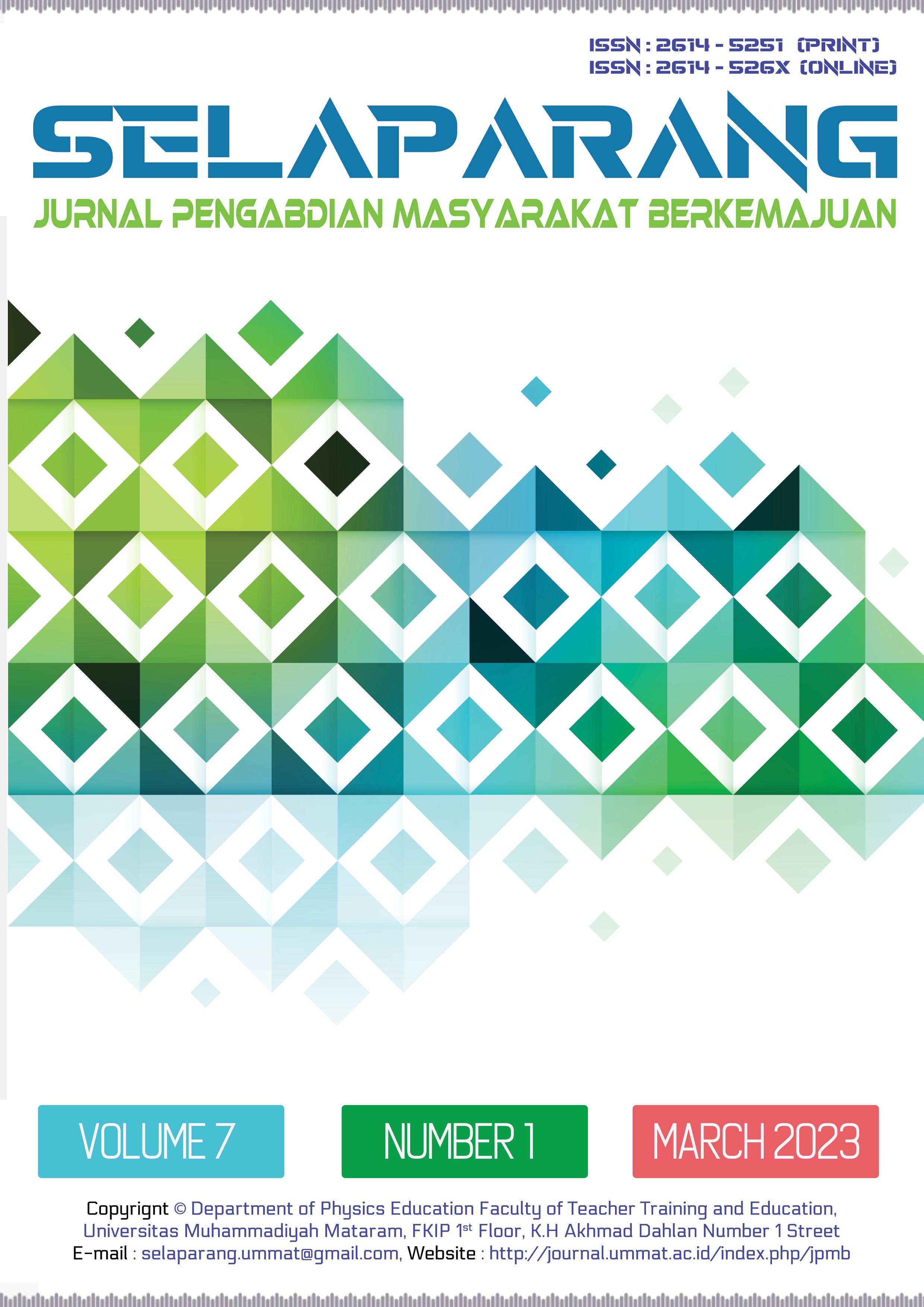PENGOLAHAN LIMBAH RUMAH TANGGA MENJADI MIKRO ORGANISME LOKAL (MOL) DI PADUKUHAN KROBOKAN BERSAMA KELOMPOK WANITA TANI KEMBANG HARAPAN
DOI:
https://doi.org/10.31764/jpmb.v7i1.13687Keywords:
household waste, MOL, counseling, krobokan hamlet.Abstract
ABSTRAK
Limbah rumah tangga merupakan penghasil limbah terbesar dibandingkan penghasil limbah lainnya, di mana jenis limbah makanan merupakan yang paling banyak. Pengelolaan limbah rumah tangga merupakan tantangan utama di berbagai daerah di Indonesia, termasuk di Padukuhan Krobokan, Kelurahan Tamanan, Kecamatana Banguntapan, Kabupaten Bantul. Persoalan pengelolahan limbah rumah tangga di Padukuhan Krobokan masih pada tahap pemilahan jenis limbah baik organik maupun anorganik. Namun untuk pemanfaatan limbah seperti diolah menjadi pupuk organik belum dilakukan, sehingga sebagian besar limbah rumah tangga yang dihasilkan masih bertumpuk di TPA. Penyuluhan ini bertujuan untuk meningkatkan pengetahuan warga khususnya Ibu-ibu anggota KWT untuk membuat Mikro Organisme Lokal melalui limbah organik rumah tangga secara mandiri, sehingga pemanfaatan limbah rumah tangga yang ada di Padukuhan Krobokan dapat dimaksimalkan untuk pupuk tanaman. Metode pelaksanaan dilakukan melalui lima tahap, yaitu, pengenalan masalah, penyediaan alat dan bahan, penyuluhan, praktik dan penggunaan MOL. Kegiatan penyuluhan berjalan dengan tertib dan lancar, ibu-ibu kelompok wanita tani sangat antusias terhadap kegiatan penyuluhan. Hal ini ditandai dengan banyaknya pertanyaan dan diskusi selama penyuluhan berlangsung.
Â
Kata kunci: limbah rumah tangga; MOL; penyuluhan; padukuhan krobokan.
Â
ABSTRACT
Household waste is the biggest waste producer compared to other waste producers, where the type of food waste is the most. Household waste management is a big challenge in various regions in Indonesia, including in Krobokan Hamlet, Tamanan Village, Banguntapan District, Bantul Regency. The problem of managing household waste in Krobokan Hamlet is still in the stage of sorting out the types of waste, both organic and inorganic. However, the use of waste such as processing it into organic fertilizer has not been widely carried out, so that most of the household waste produced still accumulates in landfills. This counseling aims to increase the knowledge of residents, especially KWT members, to make Local Micro-Organisms through household organic waste independently, so that the utilization of household waste in Krobokan Hamlet can be maximized for plant fertilizer. The implementation method is carried out through five stages, namely, problem recognition, provision of tools and materials, counseling, practice and use of MOL. The counseling activities ran in an orderly and smooth manner, the farmer women's group was very enthusiastic about participating in the extension activities. This is shown by the many questions and discussions during the extension.
Â
Keywords: household waste; MOL; counseling; krobokan hamlet.
References
Benyahya, Y., Fail, A., Alali, A., & Sadik, M. (2022). Recovery of Household Waste by Generation of Biogas as Energy and Compost as Bio-Fertilizer—A Review. Processes, 10(1). https://doi.org/10.3390/pr10010081
Budiyani, N., Soniari, N., & Sutari, N. (2016). Analisis Kualitas Larutan Mikroorganisme Lokal (Mol) Bonggol Pisang. E-Jurnal Agroekoteknologi Tropika (Journal of Tropical Agroecotechnology), 5(1), 63–72.
Febria, F. A., & Rahayu, S. (2021). Development of Local Microorganism from Organic Waste as an Alternative Product for EM4. International Journal of Progressive Sciences and Technologies (IJPSAT), 30(1), 98–105.
Hudha, A. M. I., GalihPurwa S., B. G., RikardusYohanes D. B., C. R., & Kartika D, D. R. (2022). Manufacture of Local Microorganism (MOL) from Vegetable Waste with Nutrition Source Supply Variation. Tibuana, 5(01), 34–40. https://doi.org/10.36456/tibuana.5.01.5028.34-40
Indasah, I., & Muhith, A. (2020). Local Microorganism from “tape†(Fermented Cassava) in Composition and Its Effect on Physical, Chemical and Biological Quality in Environmental. IOP Conference Series: Earth and Environmental Science, 519(1). https://doi.org/10.1088/1755-1315/519/1/012003
Kurniawan, T. A., Meidianab, C., Othmanc, M. H. D., Goh, H. H., & Chewe, K. W. (2023). Strengthening waste recycling industry in Malang (Indonesia): Lessons from waste management in the era of Industry 4.0. Journal of Cleaner Production, 382(1 January), 135296. https://doi.org/https://doi.org/10.1016/j.jclepro.2022.135296
Kurniawati, D. (2019). Mudahnya Membuat Mikroorganisme Lokal (MOL) Sendiri. DPKP DIY. https://dpkp.jogjaprov.go.id/baca/Mudahnya+Membuat+Mikroorganisme+Lokal+(MOL)+Sendiri/090819/20e5d467ceacc0a4a6ca1902a256aefff7f168ee476662864ef5b4fb98ab443350#:~:text=Setelah 5 hari MOL sudah,aroma alkohol dari larutan tersebut
Kusmanto, H., Darmawan, R., Kisnaria, B., & Setiyadi, Y. B. (2019). Realisasi Literasi Lingkungan Melalui Workshop Mikro Organisme Lokal (MOL). Buletin KKN Pendidikan, 1(1), 1–9. https://doi.org/10.23917/bkkndik.v1i1.9281
Lin, L., Xu, F., Ge, X., & Li, Y. (2018). Improving the sustainability of organic waste management practices in the food-energy-water nexus: A comparative review of anaerobic digestion and composting. Renewable and Sustainable Energy Reviews, 89, 151–167. https://doi.org/10.1016/j.rser.2018.03.025
Lin, W., Lin, M., Zhou, H., Wu, H., Li, Z., & Lin, W. (2019). The effects of chemical and organic fertilizer usage on rhizosphere soil in tea orchards. PLoS ONE, 14(5), 1–16. https://doi.org/10.1371/journal.pone.0217018
Meyer-Kohlstock, D., Schmitz, T., & Kraft, E. (2015). Organicwaste for compost and biochar in the Eu: Mobilizing the potential. Resources, 4(3), 457–475. https://doi.org/10.3390/resources4030457
Priambodo, S. R., Susila, K. D., & Soniari, N. N. (2019). Pengaruh Pupuk Hayati dan Pupuk Anorganik Terhadap Beberapa Sifat Kimia Tanah Serta Hasil Tanaman Bayam Cabut (Amaranthus tricolor) di Tanah Inceptisol Desa Pedungan. Jurnal Agroeteknologi Tropika, 8(1), 149–160. https://ojs.unud.ac.id/index.php/JAT
Roeswitawati, D., Ningsih, Y. U., & Muhidin, -. (2018). The Effect of Local Microorganism (MOL) Concentration of Banana Hump and Fruit Waste on the Growth and Yield of Broccoli Plants (Brassica oleracea). 4th International Conference on Food and Agriculture Resources (FANRes 2018) The, 172(FANRes), 310–314. https://doi.org/10.2991/fanres-18.2018.62
Suwatanti, E., & Widiyaningrum, P. (2017). Pemanfaatan MOL Limbah Sayur pada Proses Pembuatan Kompos. Jurnal MIPA, 40(1), 1–6. http://journal.unnes.ac.id/nju/index.php/JM
Vlachokostas, C., Achillas, C., Diamantis, V., Michailidou, A. V., Baginetas, K., & Aidonis, D. (2021). Supporting decision making to achieve circularity via a biodegradable waste-to-bioenergy and compost facility. Journal of Environmental Management, 285(September 2020). https://doi.org/10.1016/j.jenvman.2021.112215
Wang, S., Yang, H., Shic, Z., Zaini, I. N., Wen, Y., Jianga, J., Jönsson, P. G., & WeihongYangc. (2022). Renewable hydrogen production from the organic fraction of municipal solid waste through a novel carbon-negative process concept. Energy, 252(1), 124056.
Downloads
Published
Issue
Section
License
The copyright of the received article shall be assigned to the journal as the publisher of the journal. The intended copyright includes the right to publish the article in various forms (including reprints). The journal maintains the publishing rights to the published articles.

Selaparang : Jurnal Pengabdian Masyarakat Berkemajuan is licensed under a Creative Commons Attribution-ShareAlike 4.0 International License.

